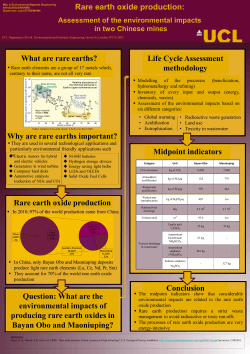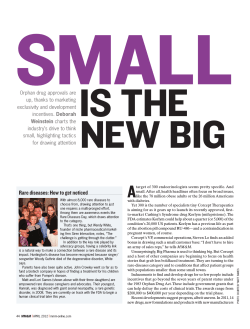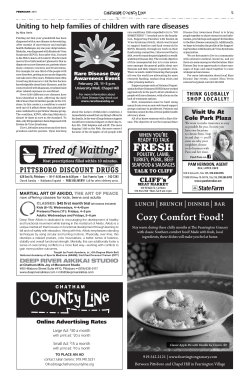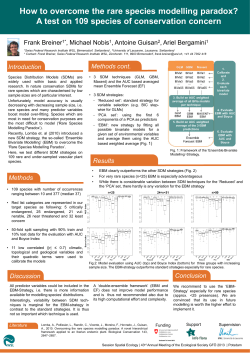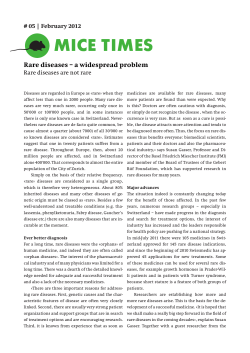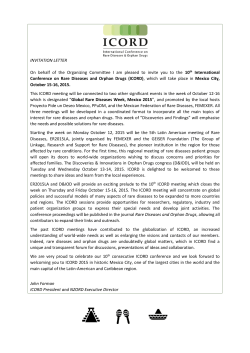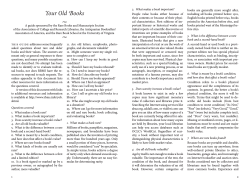
What is a Rare Disease? The Orphan Drug Act
Combating Rare Diseases in the 21st Century The Orphan Drug Act What is a Rare Disease? While there are many people afflicted with rare diseases, relatively few have any single disease. Although called rare or orphan diseases – defined as conditions affecting fewer than 200,000 people in the United States – there are more than 7,000 such conditions, affecting 30 million Americans. Collectively, rare diseases represent a significant public health challenge. These small numbers put pharmaceutical and biotech companies in a challenging situation. How do they recoup the costs of developing a new therapy, which can approach a billion dollars, for conditions that may only affect a few thousand people? Quite often these are genetic, childhood conditions, in some cases caused by a single gene mutation that may or may not be inherited from a parent’s genes. Because they are so rare, and many families may not have prior experience with the condition, simply getting a diagnosis can be an agonizing, years-long process. In addition, because these diseases are so uncommon, many doctors have no experience treating them and there may only be a handful of physicians in the world who have any experience with a given condition. To complicate matters, this small patient population can make it difficult to design an effective clinical trial. This is no small problem; there are thousands of rare diseases with no treatments. Even after diagnosis, patients still face barriers to care: 95 percent of rare diseases have not one single U.S. Food and Drug Administration (FDA) approved drug treatment. The absence of treatments for rare diseases actually used to be much worse. While many products and therapies were developed to treat cancer, heart disease and other common conditions, from 1973-1983, fewer than 10 rare disease therapies were developed. In 1983, Congress passed the Orphan Drug Act to help drug makers develop better therapies for rare conditions. The legislation’s primary goal was to reduce development costs so that companies would have greater incentives to enter these markets. The act offers federal support, such as grants and contracts, to fund clinical trials. In addition, tax credits help defray clinical testing costs. Finally, drug companies receive exclusive rights to market their drug for seven years. The Orphan Drug Act has helped make it more profitable for companies to develop rare disease therapies, which has incentivized investment, research and development. The FDA’s Office of Orphan Products Development (OOPD) has designated 2,200 potential therapies as orphan drugs and approved 360. In addition, 460 more treatments are currently being developed. Newer legislation has built on the Orphan Drug Act’s success. Most recently, the FDA Safety and Innovation Act of 2012 (FDASIA) created the breakthrough therapy designation, which seeks to expedite drug development for serious or life-threatening illnesses. Sources: U.S. Food and Drug Administration, National Institutes of Health, PhRMA However, passage of the Orphan Drug Act in 1983 (see sidebar) significantly improved the therapeutic landscape, providing drug makers added incentives to invest in research to develop treatments for these small populations. Additional insights from genomic sequencing and other technologies have helped identify new treatment targets. RARE DISEASES BY THE NUMBERS A disease is defined as orphan in the U.S. when it affects fewer than 200,000 PEOPLE 30 MILLION PEOPLE in the U.S. are living with a rare disease. This equates to 1 in 10 Americans There are approximately 7,000 TYPES of rare diseases and disorders 80% of rare diseases are genec in origin Approximately 50% of those affected by rare disease are children 8 30% of children with a rare disease will not live to see their fih birthday 3 95% of rare diseases have no FDA-approved drug treatment 7+ yrs Average number of Average number Average me unl While broadly designed physicians visits of misdiagnoses diagnosis before diagnosis to increase access to affordable healthcare for Americans, implementation of the Affordable Care Act (ACA) now offers an important opportunity to address the specific needs of rare disease patients. For example, most insurance plans require patients to get care “in-network” to avoid onerous costs. However, rare disease patients must often see specialists “out-of-network,” and the costs of such care may not be covered by their health plan or count toward out-of-pocket limits established by the ACA intended to make care more affordable for patients. SOURCES: Naonal Organizaon for Rare Diseases, Global Genes Project Historical Orphan Indication Approvals # of Orphan Indicaon Approvals 30 25 24 22 21 20 19 15 10 14 10 11 10 7 5 0 5 11 6 4 2000 2001 2002 2003 2004 2005 2006 2007 2008 2009 2010 2011 2012 Source: Biotech Now This and other insurance coverage and access issues (see Coverage and Access on back page) can make it difficult for patients to find the care they need. However, as evidenced by the Orphan Drug Act, thoughtful federal and state-level public policy solutions can help families overcome these barriers, improve healthcare access and quality, and control costs. Sources: U.S. Food and Drug Administration, National Institutes of Health, National Organization for Rare Disorders, EveryLife Foundation for Rare Diseases RARE DISEASE DAY Every year, Rare Disease Day is observed on the last day of February. The event is designed to raise awareness about these conditions, help patients access better treatments and highlight policy solutions. a patient’s story Sarah Lewis did not think twice about eating a tart at her sister’s graduation reception, but the dessert precipitated a health odyssey that could continue for the rest of her life. Rare Disease Day has another, no less important goal—to unite the rare disease community. Events held in more than 70 countries around the world encourage patients, family members, advocates, physicians, scientists and policymakers to share their stories and develop a better consensus on how to move forward. Soon after the reception, Lewis, a mother of two from California’s Central Coast, discovered she had salmonella from tainted eggs in the tart. She was in and out of the hospital for weeks and was later diagnosed with C. difficile, an opportunistic infection that often strikes people with suppressed immunity. The Lewis Family But for Lewis, this was just the beginning. Over the next two years, she continued to suffer a variety of symptoms: gastrointestinal issues, joint pain and lesions on her body. Her doctors ordered multiple, invasive tests but no one could diagnose her condition. “They thought I had lymphoma, several different rare cancers, colitis, basically everything under the sun,” says Lewis. “Nobody could figure out what in the world was wrong with me.” Two years later, the medical community was still mystified. However, by chance, the Lewis family’s accountant had recently read an article about Behçet’s disease. Because most rare diseases only affect a few thousand people, a single day to recognize all these conditions focuses both media attention and public concern. The events provide a unique opportunity for people to learn how these conditions impact patients’ health and quality-of-life. Since Rare Disease Day was first launched by Rare Disease Europe (EURORDIS) in 2008, thousands of events have generated extensive media coverage, educated the public, enhanced advocacy and improved public policy. “We looked it up, and I couldn’t even breathe. I thought, no way—that’s me,” says Lewis. Doctors confirmed the diagnosis. There is no known relationship between salmonella and Behçet’s, but Lewis’s immune system may have been so compromised that she became vulnerable to the genetic mutation. While Lewis has a diagnosis, her problems are far from over. She continues to deal with joint pain, severe fatigue and lesions. Because she is the only patient with Behçet’s in the area, her physicians have had to figure out from scratch how to treat her. She is currently on chemotherapy, prednisone and a variety of pain killers. Like many patients with a rare disease, she holds out hope that research will eventually provide better options. “We looked it up, and I couldn’t even breathe. I thought, no way—that’s me.” - Sarah Lewis “There’s no specific medication for Behçet’s,” says Lewis. “There’s nothing that can cure you, it’s just trial and error.” Source: EURORDIS The Rare Diseases Genome Project Because many rare diseases are caused by genetic mutations, whole genome sequencing holds great promise to help diagnose these issues and highlight potential treatment targets. To take advantage of this technology San Diego-based Illumina, the University of Cambridge and Genomics England are working on a three-year project to sequence the whole genome of 10,000 patients suffering from rare diseases. One of the primary goals is to improve diagnostics. Many patients and their families must wait months or years to have a rare condition diagnosed. Traditional genetic testing can only address a few genes at a time. As a result, physicians must often provide their best guess on which genes to investigate. If the test is negative, further testing will be required, an expensive and timeconsuming process. Because next generation sequencing looks at the entire genome, it could diagnose a rare condition in a few days, providing the critical knowledge physicians and patients need to address the disease head-on. The project’s ultimate goal is to bring these advanced diagnostics to all patients with rare conditions. In addition, genetic data will help provide vital clues for researchers, clinicians and drug companies, helping them identify the mechanisms behind these diseases to develop new therapies. Source: University of Cambridge Treatments for Rare Diseases There are at least 7,000 rare diseases, the majority of which have no approved treatments. However, pharmaceutical and biotech companies are working hard to develop new therapies. Here is a small sampling of their efforts. ALEXION VERTEX Alexion is a global leader in complement inhibition: the company’s first product, Soliris (eculizumab), is the world’s first and only approved terminal complement inhibitor. Soliris works by selectively targeting and blocking the complement cascade – a normal part of the immune system that, when activated inappropriately creates life-long risk for life-threatening complications. Soliris is currently approved for the treatment of paroxysmal nocturnal hemoglobinuria (PNH), and for the treatment of atypical hemolytic uremic syndrome (aHUS). Both PNH and aHUS are life-threatening, ultra-rare diseases that are caused by chronic uncontrolled complement activation. Cystic Fibrosis (CF) is an inherited chronic disease that affects the lungs and digestive system of about 30,000 children and adults in the United States. A defective gene and its protein product cause the body to produce unusually thick, sticky mucus that clogs the lungs and leads to life-threatening lung infections and obstructs the pancreas and stops natural enzymes from helping the body break down and absorb food. In the 1950s, few children with cystic fibrosis lived to attend elementary school. Today, advances in research and medical treatments have further enhanced and extended life for children and adults with CF. Many people with the disease can now expect to live into their 30s, 40s and beyond. The FDA has also granted breakthrough therapy designation to asfotase alfa for the treatment of patients with hypophosphatasia (HPP). HPP is an inherited, life-threatening, ultrarare metabolic disorder that leads to progressive damage to multiple vital organs, including destruction and deformity of bones. Vertex has developed a groundbreaking treatment Kalydeco (ivacaftor), which helps that defective protein work in the cells to allow salt and fluid to move into the airways. In turn, this helps thin the thick, sticky mucus caused by CF that builds up in the lungs, making it is easier to cough out. The company has several additional CF drugs in the pipeline. BIOMARIN Lysosomal Storage Disorders (LSDs) are inherited disorders caused by deficiency of enzymes to break down certain complex carbohydrates known as glycosaminoglycans (GAGs). Mucopolysaccharidosis (MPS) diseases are types of LSDs. BioMarin has five approved therapies. Naglazyme (galsulfase) treats MPS VI. Aldurazyme (laronidase) is used for MPS I, which affects multiple organs and cognitive development. Kuvan (sapropterin dihydrochloride) treats Phenylkentonuria. Kuvan is the first and only FDA-approved medication for PKU to reduce blood Phe levels in patients. Vimizim (elosulfase alfa) was recently approved to treat Morquio, a syndrome which causes a wide range of developmental issues. Firdapse (amifampridine), currently approved in the EU, is the first and only approved drug for the symptomatic treatment of Lambert-Eaton Myasthenic Syndrome in adults, a rare autoimmune disease with the primary symptoms of muscle weakness. BioMarin is also working on treatments for Pompe disease, Batten disease, genetically defined cancers and Achondroplasia, the most common cause of dwarfism. GENZYME Genzyme is committed to discovering and delivering transformative therapies for patients with rare and special unmet medical needs, providing hope where there was none before. Focused on LSDs, Genzyme has launched a number of therapies for these disorders. Cerezyme (imiglucerase) treats Gaucher disease, in which fat accumulates in organs, leading to fatigue and anemia. Fabrazyme (agalsidase beta) treats Fabry disease, a systemic condition that can damage the kidneys, heart, eyes, skin and other systems. Myozyme (alglucosidase alfa) was developed to treat Pompe disease, which impairs nerve and muscle cells. Pompe disease and the story of Genzyme’s founding were highlighted in the 2010 Harrison Ford movie, “Extraordinary Measures.” Genzyme is also working on a new treatment for Niemann-Pick disease, another disorder that causes fats to accumulate in cells. XOMA Behçet’s uveitis, a subset of non-infectious uveitis, is the chronic inflammation of the eyes’ blood vessels, which threatens vision. The FDA has granted orphan drug designation to gevokizumab, XOMA’s IL-1 beta modulating antibody, for Behçet’s uveitis and other forms of non-infectious uveitis. Gevokizumab also may have potential to treat pyoderma gangrenosum, a rare severe inflammatory skin disease. XOMA also developed XMet D, a monoclonal antibody, to deactivate the insulin receptor and normalize glucose levels. XMet D is in preclinical development as a potential treatment for patients diagnosed with congenital hyperinsulinism, which is an overabundance of insulin in the body that can severely affect a person’s ability to balance blood sugar. ORPHAN DRUGS CLINICAL TRIALS 73% of biopharma innovators FIND WORKING IN A RARE DISEASE TRIAL MORE REWARDING THAN REGULAR TRIALS 2,400% 75% RARE DISEASE CLINICAL TRIALS ON AVERAGE COST 2,400% MORE PER PATIENT THAN A REGULAR TRIAL OF RARE DISEASE CLINICAL TRIALS ARE OUTSOURCED TO A Clinical Research Organization 69% 43% of biopharma innovators FIND CHOOSING A CLINICAL SITE ONE OF THE TOUGHEST CHALLENGES of biopharma innovators FIND SECURING APPROVAL FOR rare disease TRIAL DESIGNS CHALLENGING Source: Total Orphan Drugs, Premier Research COMMUNITY RESOURCES American Behçet’s Disease Association www.behcets.com COVERAGE AND ACCESS FasterCures www.fastercures.org Genetic Alliance www.geneticalliance.org Genetic and Rare Disease Information Center www.rarediseases.info.nih.gov/GARD Global Genes Project www.globalgenes.org National Organization for Rare Disorders (NORD) www.rarediseases.org Office of Rare Disease Research www.rarediseases.info.nih.gov PhRMA www.phrma.org/research/rarediseases Rare Diseases Clinical Research Network www.rarediseasesnetwork.epi.usf.edu Rare Disease Legislative Advocates (RDLA) www.rareadvocates.org Rare Disease Day www.rarediseaseday.org Rare Diseases with FDA-Approved Medical Products www.rarediseases.info.nih.gov/gard/ diseases-with-medical-products U.S. Food and Drug Administration, Office of Orphan Products Development (OOPD) http://1.usa.gov/1n3l4hD The Orphan Drug Act of 1983 helped spur development of drugs for rare diseases, leading to 360 approved treatments for 200 conditions. While this has been a great public policy success, there is still work to do, as there are roughly 6,800 rare diseases with no approved treatments. Even when therapies that treat a patient’s condition are available, such products are not always accessible to patients because of health insurance coverage policies, such as limited provider networks and specialty tier placement, which can create potential barriers and delays to treatment. The ACA achieved many important safeguards for the rare disease patient community – such as the elimination of pre-existing condition exclusions and annual and lifetime coverage limits – but more must be done to expand access to appropriate care for patients battling rare diseases. To control costs, insurers create physician networks. When patients go outside their network, they often incur much higher costs. This is generally not a problem for people with common diseases, as the network will generally have the needed specialists. However, since expertise for any rare disease can be limited to a handful of physicians, these patients must often go out-of-network to receive the standard of care. In addition, many patients rely on specialty pharmacies, which can also drive up their out-of-pocket expenses. The major concern is that, deterred by increased expense, patients will not see specialists who fully understand their condition. While the ACA creates strict annual out-of-pocket expense limits for patients and families, those only apply when care is provided in-network. Many believe that cost limits should be extended to out-of-network services for rare disease patients, to allow access to the best possible care without risking severe financial hardship. With respect to higher pricing, or specialty tiers, for medications, these costs can be prohibitive. A potential solution may be to cap monthly co-pays, allowing patients to get the care they need without risking financial ruin. Source: U.S. Food and Drug Administration, National Organization for Rare Disorders CHI-California Healthcare Institute is a non-profit public policy research organization for California’s biomedical R&D industry. CHI represents more than 275 leading medical device, biotechnology, diagnostics and pharmaceutical companies and public and private academic biomedical research organizations. CHI’s mission is to advance responsible public policies that foster medical innovation and promote scientific discovery. CHI’s website is www.chi.org. Follow us on Twitter @calhealthcare, Facebook, LinkedIn and YouTube. Headquarters 888 Prospect Street, Suite 220 La Jolla, California 92037 858-551-6677 | 858-551-6688 fax Sacramento 1201 K Street, Suite 1840 Sacramento, California 95814 916-233-3497 | 916-233-3498 fax Washington 1608 Rhode Island Ave. N.W., 2nd Floor Washington, DC 20036 202-974-6313 | 202-974-6330 fax
© Copyright 2025
